Details
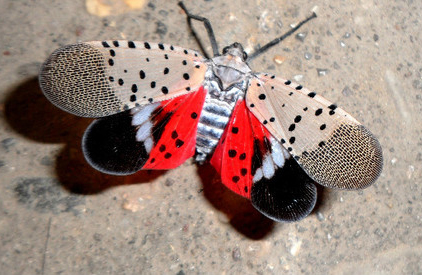 The spotted lanternfly (SLF) was detected in NJ in the summer of 2018 in Warren, Mercer, and Hunterdon Counties. Currently, SLF is detected in all 21 counties.
The spotted lanternfly (SLF) was detected in NJ in the summer of 2018 in Warren, Mercer, and Hunterdon Counties. Currently, SLF is detected in all 21 counties.
SLF is native to China, Bangladesh, and Vietnam. The first North American detection was in Pennsylvania in 2014, and has since been detected in Virginia, Delaware, Maryland, Connecticut, West Virginia, Ohio, and New Jersey. The SLF is a leaf hopper insect that feeds on the phloem of trees and plants. The SLF excretes honeydew (a sticky, sugary waste product) onto anything that is below the insect, including plants, young trees, shrubs, sidewalks, outdoor furniture, etc. In large quantities, honeydew facilitates the growth of black sooty mold that blocks photosynthesis on trees and plants. Copious amounts of honeydew can cause dieback or tree/plant mortality. In agriculture, extensive SLF feeding also causes reduced yield in crops and black sooty mold on produce reduces their marketability.
SLF has a wide host range that includes over 70 different trees, shrubs, vines, and plants. However, it has a strong preference for the tree of heaven, also called Ailanthus altissima. . Immature SLF are often found feeding on young growth, or new branches because the tissue is softer. However, as they mature into adults, they can be found at the base of the tree or feeding on the trunk. SLF can also be found feeding on maple, black walnut, grape vines, and multiflora rose.
SLF, contrary to its name, is not a fly but in fact a type of planthopper. Although SLF are able to fly, they more often jump or glide as modes of transport. SLF most effectively spread to new areas by hitchhiking rides from infested areas. Therefore it is imperative for anyone traveling in and out of known SLF areas to check their vehicles, goods, etc., for any life stages of SLF to prevent the further spread to new areas.
Susceptible Species
Prefers the invasive “Tree of Heaven,” but makes use of over 70 different plant species including fruit trees, ornamental trees, woody trees, vegetables, herbs, vines, and agricultural crops
Signs of Infestation
Any life stage of the insect is visible feeding on plants, sooty mold, heightened activity from wasps, hornets, ants, and bees
Affected Areas
Statewide.
More information
 Official Site of The State of New Jersey
Official Site of The State of New Jersey


 The spotted lanternfly (SLF) was detected in NJ in the summer of 2018 in Warren, Mercer, and Hunterdon Counties. Currently, SLF is detected in all 21 counties.
The spotted lanternfly (SLF) was detected in NJ in the summer of 2018 in Warren, Mercer, and Hunterdon Counties. Currently, SLF is detected in all 21 counties.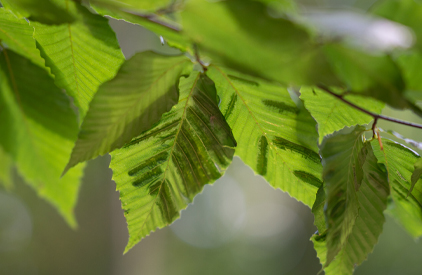 Beech leaf disease (BLD) was confirmed in New Jersey in the summer of 2020 in Bergen and Essex Counties.
Beech leaf disease (BLD) was confirmed in New Jersey in the summer of 2020 in Bergen and Essex Counties.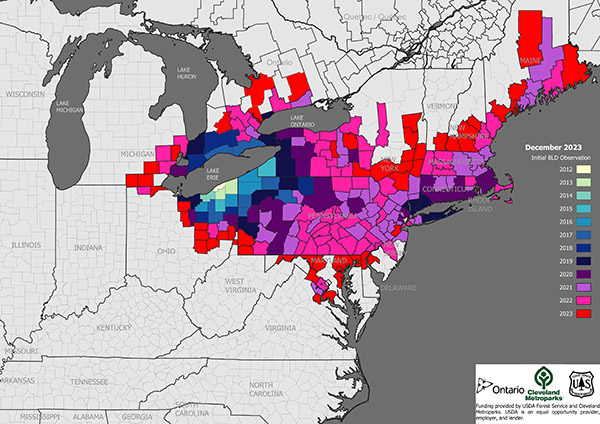
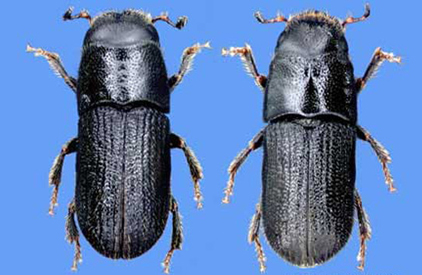 Southern pine beetle (SPB) is considered a native insect in New Jersey and was reported as causing damage in southern New Jersey in December 2001. SPB is often present in endemic (low) levels, successfully attacking weakened and stressed pine trees. However, there are also times when SPB populations reach epidemic (high) levels and they are able to successfully attack healthy pine trees. When SPB populations reach epidemic levels, they have the ability to cause significant damage across its range. It is one of the only native bark beetles that can attack healthy trees, where the adult beetles cut off water and nutrient supplies to trees by boring through the bark and creating S-shaped galleries in which they lay their eggs.
Southern pine beetle (SPB) is considered a native insect in New Jersey and was reported as causing damage in southern New Jersey in December 2001. SPB is often present in endemic (low) levels, successfully attacking weakened and stressed pine trees. However, there are also times when SPB populations reach epidemic (high) levels and they are able to successfully attack healthy pine trees. When SPB populations reach epidemic levels, they have the ability to cause significant damage across its range. It is one of the only native bark beetles that can attack healthy trees, where the adult beetles cut off water and nutrient supplies to trees by boring through the bark and creating S-shaped galleries in which they lay their eggs.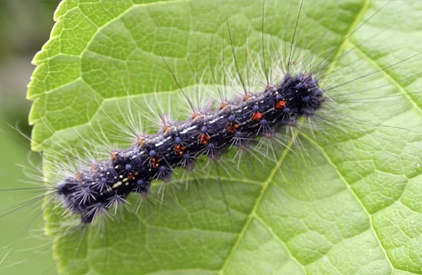 LDD was first discovered in New Jersey in 1920 and continues to be present in the environment. Fortunately, annual monitoring, suppression programs, and several established biological controls help keep gypsy moth populations in check.
LDD was first discovered in New Jersey in 1920 and continues to be present in the environment. Fortunately, annual monitoring, suppression programs, and several established biological controls help keep gypsy moth populations in check.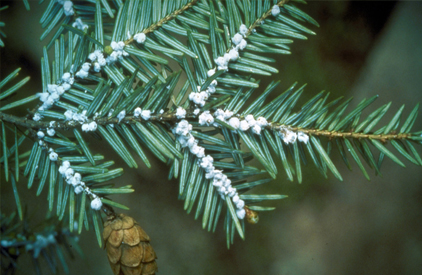
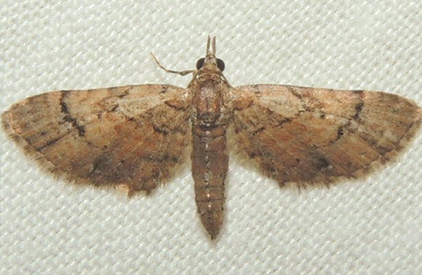 After overwintering in the soil beneath the host tree, moths emerge in May and June to lay eggs on the tree's needles. By mid-summer, the larvae hatch and eatneedles down to the sheath. When enough defoliation of host trees occur, mortality results for trees of all sizes with younger trees being most susceptible.
After overwintering in the soil beneath the host tree, moths emerge in May and June to lay eggs on the tree's needles. By mid-summer, the larvae hatch and eatneedles down to the sheath. When enough defoliation of host trees occur, mortality results for trees of all sizes with younger trees being most susceptible.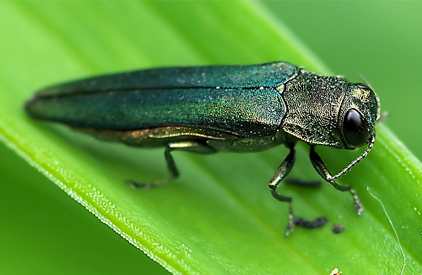 The emerald ash borer (EAB) was detected in NJ in 2014 in Somerset County, and has since been confirmed in 17 counties in the state.
The emerald ash borer (EAB) was detected in NJ in 2014 in Somerset County, and has since been confirmed in 17 counties in the state.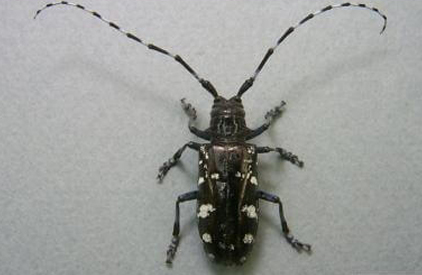 The Asian longhorned beetle (ALB) was detected in New Jersey in 2002 in Hudson County. In 2004, additional ALB populations were detected in Middlesex and Union Counties. However, as a result of an aggressive and successful ALB eradication program, in 2013, NJ deregulated the ALB quarantine zone, and no ALB have been detected in the state since.
The Asian longhorned beetle (ALB) was detected in New Jersey in 2002 in Hudson County. In 2004, additional ALB populations were detected in Middlesex and Union Counties. However, as a result of an aggressive and successful ALB eradication program, in 2013, NJ deregulated the ALB quarantine zone, and no ALB have been detected in the state since.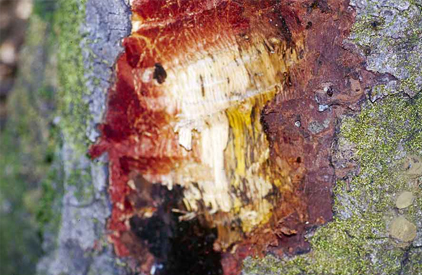 Although the origin of sudden oak death (SOD) is still unknown, its detrimental impacts on North American oak species suggest the pathogen is non-native. SOD is a fungal pathogen that was first discovered in California in the mid-1990s and then in Oregon in 2001. SOD is responsible for the mortality of millions of coast live oak and tanoaks in California and Oregon.
Although the origin of sudden oak death (SOD) is still unknown, its detrimental impacts on North American oak species suggest the pathogen is non-native. SOD is a fungal pathogen that was first discovered in California in the mid-1990s and then in Oregon in 2001. SOD is responsible for the mortality of millions of coast live oak and tanoaks in California and Oregon.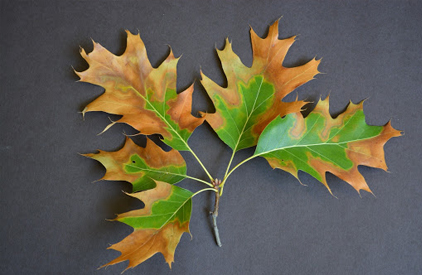 Although bacterial leaf scorch (BLS) is considered native to NJ, it was first observed causing tree damage and mortality around 1985 in the southern half of the state, mainly affecting trees in the Red Oak family, such as Northern red oak, pin oak, and scarlet oak. Today, BLS can be found statewide, affecting landscape and street trees as well as those growing in forests.
Although bacterial leaf scorch (BLS) is considered native to NJ, it was first observed causing tree damage and mortality around 1985 in the southern half of the state, mainly affecting trees in the Red Oak family, such as Northern red oak, pin oak, and scarlet oak. Today, BLS can be found statewide, affecting landscape and street trees as well as those growing in forests.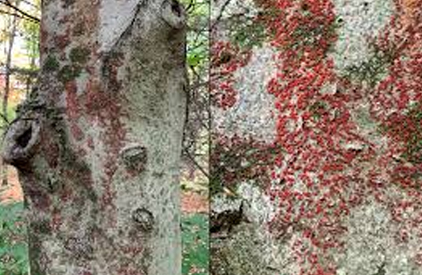 BBD was detected in New Jersey in 1935, and has impacted American beech trees and forests in the northern half of the state. Although low populations of beech scale have been found in the southern part of the state, the Neonectria fungi have not yet been detected in South Jersey.
BBD was detected in New Jersey in 1935, and has impacted American beech trees and forests in the northern half of the state. Although low populations of beech scale have been found in the southern part of the state, the Neonectria fungi have not yet been detected in South Jersey.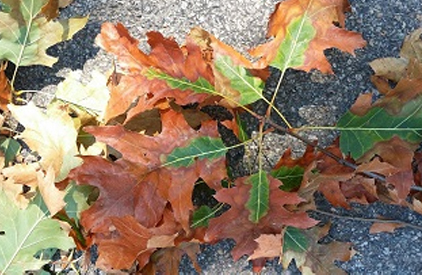 Oak wilt is a fungus that causes rapid mortality in oak trees around July - September. Oak trees in the red oak family are more susceptible than those in the white oak family, but both can be infected with the fungus. Red oak trees can die within weeks or months after infection, whereas white oak trees die after a year or more. Oak wilt has not yet been detected in NJ, but has been detected in neighboring states including New York and Pennsylvania.
Oak wilt is a fungus that causes rapid mortality in oak trees around July - September. Oak trees in the red oak family are more susceptible than those in the white oak family, but both can be infected with the fungus. Red oak trees can die within weeks or months after infection, whereas white oak trees die after a year or more. Oak wilt has not yet been detected in NJ, but has been detected in neighboring states including New York and Pennsylvania.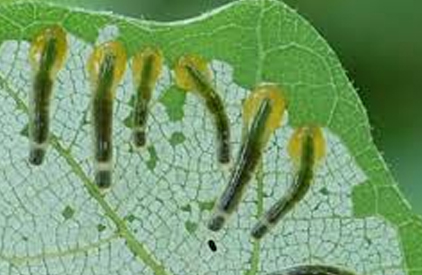 Larvae feed on the bottom of oak leaves, leaving only a leaf skeleton of veins behind. Repeated defoliations may affect vigor or kill the tree.
Larvae feed on the bottom of oak leaves, leaving only a leaf skeleton of veins behind. Repeated defoliations may affect vigor or kill the tree. Thousand cankers disease (TCD) is a disease-insect complex between a fungus (Geosmithia morbida) and the walnut twig beetle (WTB) (Pityophthorus juglandis), believed to be native to the western states. Although WTB and Geosmithia are found in western walnut species, it mainly affects trees that are already under stress or declining. However, in black walnut, an eastern species, TCD successfully infects healthy trees, causing cankers, dieback, and eventual tree death.
Thousand cankers disease (TCD) is a disease-insect complex between a fungus (Geosmithia morbida) and the walnut twig beetle (WTB) (Pityophthorus juglandis), believed to be native to the western states. Although WTB and Geosmithia are found in western walnut species, it mainly affects trees that are already under stress or declining. However, in black walnut, an eastern species, TCD successfully infects healthy trees, causing cankers, dieback, and eventual tree death.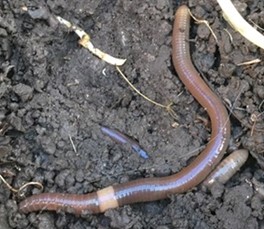 Jumping worms, first identified in Wisconsin in 2013, are an invasive earthworm introduced to North America from Asia. Jumping worms differ from other earthworms as they live close to the soil surface, devouring the organic soil and leaf litter layers leaving behind massive amounts of coffee ground-like excrement known as castings. Presence of these worms is extremely detrimental to the Northeast as seedling recruitment and regeneration is largely dependent on available litter layer and organic material necessary for seed germination. Limited organic matter and leaf litter layer also negatively impacts small reptiles, ground nesting birds and small mammals.
Jumping worms, first identified in Wisconsin in 2013, are an invasive earthworm introduced to North America from Asia. Jumping worms differ from other earthworms as they live close to the soil surface, devouring the organic soil and leaf litter layers leaving behind massive amounts of coffee ground-like excrement known as castings. Presence of these worms is extremely detrimental to the Northeast as seedling recruitment and regeneration is largely dependent on available litter layer and organic material necessary for seed germination. Limited organic matter and leaf litter layer also negatively impacts small reptiles, ground nesting birds and small mammals.
 Originally from Asia, The Elm Zigzag Sawfly (EZZ) was first discovered in Europe in 2003, Québec in 2020, and Frederick County, Virginia in 2021. Since 2021, EZZ has been detected in Pennsylvania, Maryland, New York, Vermont, and North Carolina. Feeding characteristic of EZZ was detected in Sussex County New Jersey in 2023 but insect specimens have not yet been collected. EZZ is a foliage feeder with a wide range of host plants but represents a threat to elm trees of the genus Ulmus in the United States. EZZ defoliates elm trees and leaves behind a unique ‘zigzag’ pattern on leaves it feeds upon. EZZ is a newly emerging pest in the United States and its potential range and impacts remain to be further studied.
Originally from Asia, The Elm Zigzag Sawfly (EZZ) was first discovered in Europe in 2003, Québec in 2020, and Frederick County, Virginia in 2021. Since 2021, EZZ has been detected in Pennsylvania, Maryland, New York, Vermont, and North Carolina. Feeding characteristic of EZZ was detected in Sussex County New Jersey in 2023 but insect specimens have not yet been collected. EZZ is a foliage feeder with a wide range of host plants but represents a threat to elm trees of the genus Ulmus in the United States. EZZ defoliates elm trees and leaves behind a unique ‘zigzag’ pattern on leaves it feeds upon. EZZ is a newly emerging pest in the United States and its potential range and impacts remain to be further studied.
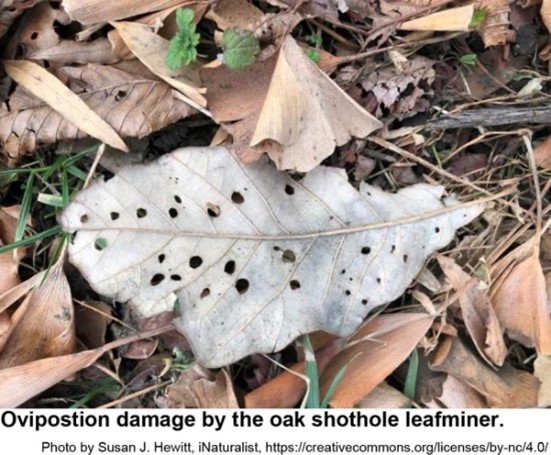 Oak Shothole Leafminer is a small species of fly in the family Agromyzidae and is native to most of the east coast from Maine to Georgia. The fly is commonly found throughout NJ, where adult females feed on buds and newly emerged leaves of oaks. The feeding behavior results in a small circular incision which increases in size as oak leaves continue to grow in Spring and early Summer. Although damage from Oak Shothole Leafminer can be widespread and significant, the flies are kept in check by native control agents preventing widespread tree mortality and the need for insecticide use.
Oak Shothole Leafminer is a small species of fly in the family Agromyzidae and is native to most of the east coast from Maine to Georgia. The fly is commonly found throughout NJ, where adult females feed on buds and newly emerged leaves of oaks. The feeding behavior results in a small circular incision which increases in size as oak leaves continue to grow in Spring and early Summer. Although damage from Oak Shothole Leafminer can be widespread and significant, the flies are kept in check by native control agents preventing widespread tree mortality and the need for insecticide use.
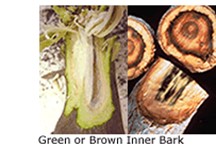 Verticillium Wilt is caused by two species of soil borne fungi, Verticillium dahlia and Verticillium albo-atrum. The fungus enters a tree through the root system where the fungus restricts the flow of water to certain parts of the tree resulting in the yellowing of leaves and wilting of branches.
Verticillium Wilt is caused by two species of soil borne fungi, Verticillium dahlia and Verticillium albo-atrum. The fungus enters a tree through the root system where the fungus restricts the flow of water to certain parts of the tree resulting in the yellowing of leaves and wilting of branches.
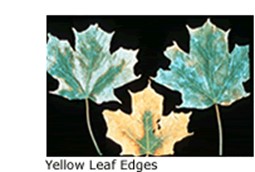
 Fall Webworm is a species of moth native to the United States. Adult females will lay eggs under the leaves of deciduous trees and shrubs between July and August. When eggs hatch, larvae will spin a small web over foliage to feed on. The web size will increase and expand it as larvae continue to feed. The moths are a minor insect pest and do not kill host trees. Populations of Fall Webworm are kept in check by native parasites and predators.
Fall Webworm is a species of moth native to the United States. Adult females will lay eggs under the leaves of deciduous trees and shrubs between July and August. When eggs hatch, larvae will spin a small web over foliage to feed on. The web size will increase and expand it as larvae continue to feed. The moths are a minor insect pest and do not kill host trees. Populations of Fall Webworm are kept in check by native parasites and predators.
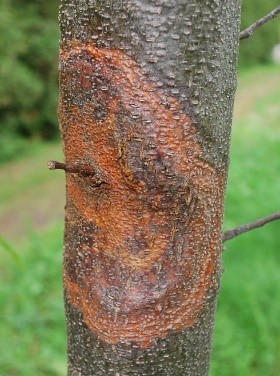 The Chestnut Blight fungus, Cryphonectria parasitica, is native to Asia and was first introduced to North America in the early 1900s. The fungus originally infects its native host trees, the Chinese chestnut (Castanea mollissima) and the Japanese chestnut (Castanea crenata). When introduced into the United States, the fungus spread rapidly across the wide range of American chestnut, Castanea dentata. Mortality of most adult American chestnut trees had been observed by the 1940s. The Chestnut blight enters through wounds of trees and attacks the inner bark and cambium of susceptible trees that ultimately girdle the tree, causing chronic dieback or mortality of the tree. American chestnut trees can still be found in forests of New Jersey but are often of small diameter with many stump sprouts from continual dieback caused by the fungus. Starting in the 1930s and continuing today, efforts are underway to repopulate the United States with new varieties and hybrids of American chestnut trees that are resistant to the blight.
The Chestnut Blight fungus, Cryphonectria parasitica, is native to Asia and was first introduced to North America in the early 1900s. The fungus originally infects its native host trees, the Chinese chestnut (Castanea mollissima) and the Japanese chestnut (Castanea crenata). When introduced into the United States, the fungus spread rapidly across the wide range of American chestnut, Castanea dentata. Mortality of most adult American chestnut trees had been observed by the 1940s. The Chestnut blight enters through wounds of trees and attacks the inner bark and cambium of susceptible trees that ultimately girdle the tree, causing chronic dieback or mortality of the tree. American chestnut trees can still be found in forests of New Jersey but are often of small diameter with many stump sprouts from continual dieback caused by the fungus. Starting in the 1930s and continuing today, efforts are underway to repopulate the United States with new varieties and hybrids of American chestnut trees that are resistant to the blight.
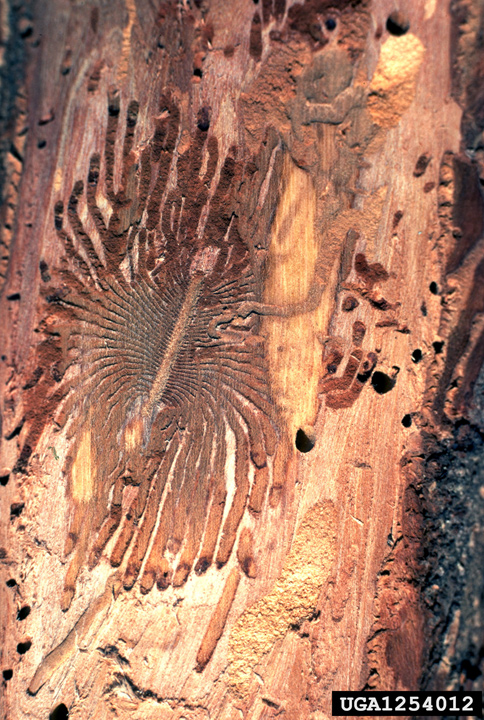 Dutch elm disease (DED) is caused by a fungus spread by several species of elm bark beetles with the most common including Hylurgopinus rufipes, Scolytus multistriatus, Scolytus schevyrewi. The fungus is endemic to Asia but was accidentally introduced to Europe and was identified in the Netherlands in the 1920s by Dutch scientists. DED was first introduced to the United States in the 1930s and has caused wide-spread mortality of the elm species since introduction. The fungus infects the tree through elm bark beetles and larvae. In an attempt to stop the virus from spreading, elm trees will plug areas of their vascular system that causes decline which is noticeable in a trees canopy and ultimately, mortality of the tree.
Dutch elm disease (DED) is caused by a fungus spread by several species of elm bark beetles with the most common including Hylurgopinus rufipes, Scolytus multistriatus, Scolytus schevyrewi. The fungus is endemic to Asia but was accidentally introduced to Europe and was identified in the Netherlands in the 1920s by Dutch scientists. DED was first introduced to the United States in the 1930s and has caused wide-spread mortality of the elm species since introduction. The fungus infects the tree through elm bark beetles and larvae. In an attempt to stop the virus from spreading, elm trees will plug areas of their vascular system that causes decline which is noticeable in a trees canopy and ultimately, mortality of the tree.